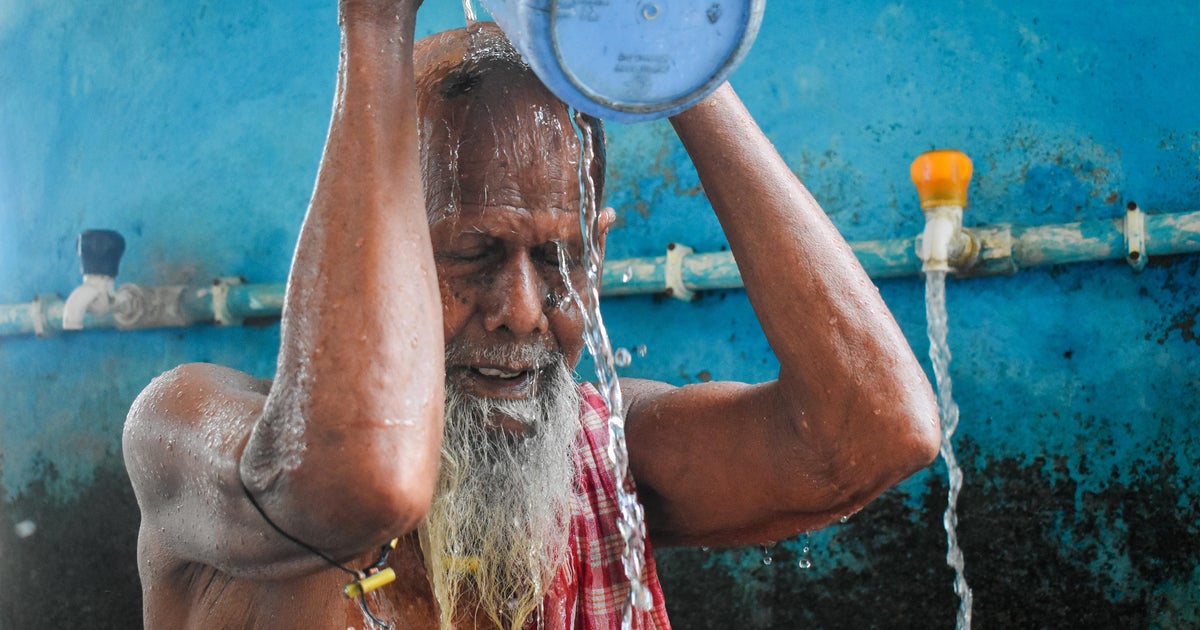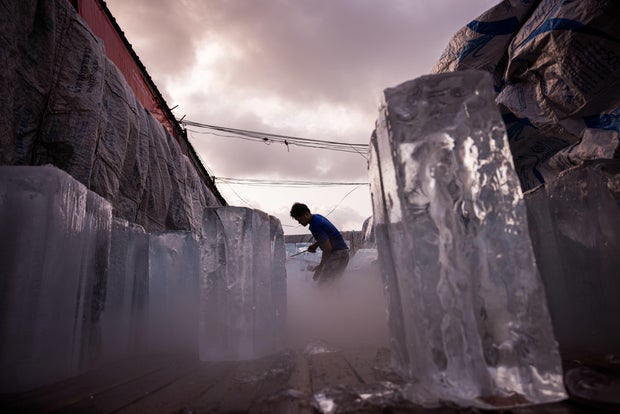CBS News
Scientists uncover reason that made Asia’s deadly heat wave 45 times more likely. And it could happen again.

Hundreds of people died across Asia in recent weeks as the region sweltered under blistering temperatures. And a new study determined a leading factor in how it all happened.
Last month, many areas in India saw temperatures well above triple digits. The country’s meteorological service says that heat waves are not uncommon between March and June, with May being the “peak month” for the extreme weather event. In Bhagdora, India, last month, temperatures hit nearly 115 degrees Fahrenheit as the India Meteorological Department issued a red alert warning, meaning that severe heat was expected to persist for more than two days and there was a very high likelihood for heat-related illnesses.
Elsewhere in the country, it was so hot that schools were canceled, an issue that people also faced in the Philippines. People in Thailand were also asked by officials to stay indoors when possible to avoid the heat, as dozens of people had already died from heat-related illnesses. According to the Associated Press, the April heat killed at least 28 people in Bangladesh, five in India and three in Gaza.
And according to the organization World Weather Attribution, it all comes down to two words – climate change.
Sudipta Das/NurPhoto via Getty Images
“The heat wave exacerbated already precarious conditions faced by internally displaced people, migrants and those in refugee camps and conflict zones across West Asia,” a new study from the organization said. “… The extreme heat has forced thousands of schools to close down in South and Southeast Asia.”
Researchers said that while the kind of heat experienced during this time “is not very rare,” it’s only being amplified by climate change, which is fueled by global warming largely caused by the burning of fossil fuels.
West Asia is anticipated to get an extreme heat event once a decade, and in the Philippines, that likelihood is even less, about once every 20 years when El Niño isn’t at play. In South Asia at large, extreme heat is not common.
Andre Malerba/Bloomberg via Getty Images
“An extremely warm April such as this one is a somewhat rarer event, with a 3% probability of happening in a given year – or once every 30 years,” researchers said, adding that observations and data models show that human-caused climate change creates a “strong increase in likelihood and intensity.”
“In the Philippines, the change in likelihood is so large that the event would have been impossible without human-caused climate change,” they said. “In West Asia, climate change increased the probability of the event by about a factor of 5.”
The average April temperatures in South Asia, which the group has studied twice in the last two years from other extreme events, “are now about 45 times more likely and 0.85 degrees Celsius hotter,” they found.
“Sounds like a broken record – yes! But heat is still underreported, underrecorded and extremely deadly,” Friederike Otto, who is part of the World Weather Attribution study, said on social media. “The world is not prepared for today’s climate change, let alone the future.”
Extreme heat is “becoming the silent killer,” Ko Barrett, deputy secretary-general of the World Meteorological Organization, said in April.
“Heat-related mortality is widely under-reported and so the true scale of premature deaths and economic costs – in terms of reduced labor productivity, agricultural losses, and stress on the power grid – is not accurately reflected in the statistics,” she said.
The report from the World Weather Attribution came a day ahead of another report from the WMO that found this April was the warmest one on record and the 11th consecutive month of record temperature worldwide.
The average surface air temperature last month was 15.03 degrees Celsius, about 59 degrees Fahrenheit, more than 1.5 degrees Celsius warmer than pre-industrial times. Scientists have warned that if the planet experiences persistent temperatures at that 1.5 threshold, it could cause significant impacts on weather events leading to global issues surrounding food and water availability, migration and infrastructure.
“The record temperatures were accompanied by high-impact weather events — including intense heat in many parts of Asia,” the WMO said. “The heat also had a large impact on agriculture, causing crop damage and reduced yields, as well as on education, with holidays having to be extended and schools closed in several countries, affecting millions of students.”
It will take years of this continued breaching of 1.5 degrees above preindustrial levels for the planet to officially mean humans have failed to achieve the goals of the Paris Agreement and launched the world into a more disastrous climate era. However, 11 months of record heat – and potentially beyond – indicates “early signs of getting perilously close to exceeding the long-term limit,” the United Nations says.
“Every fraction of a degree of warming matters. With every additional increment of global warming, changes in extremes and risks become larger,” the international agency says. “… We need to bend the global emissions curve — and the production and consumption of coal, oil, and gas – downwards, starting now. A wide range of solutions exist.”
Arshad R. Zargar contributed to this report.
CBS News
Here Comes the Sun: Jack Antonoff and more

Watch CBS News
Be the first to know
Get browser notifications for breaking news, live events, and exclusive reporting.
CBS News
Capturing Moriah Wilson’s Killer – CBS News

Watch CBS News
Be the first to know
Get browser notifications for breaking news, live events, and exclusive reporting.
CBS News
How to watch the Minnesota Vikings vs. Chicago Bears NFL game today: Livestream options, more

Getty Images
The Minnesota Vikings will take on the Chicago Bears today. The Vikings are currently 8-2, an impressive run so far this season, and will be looking to add a fourth win to their current streak after last Sunday’s 23-13 win against the Tennessee Titans. The Bears, on the other hand, are entering this game on the heels of a four-game losing streak after a tough 20-19 loss against the Green Bay Packers last Sunday.
Here’s how and when you can watch the Vikings vs. Bears game today, whether or not you have cable.
How and when to watch the Minnesota Vikings vs. Chicago Bears
The Vikings vs. Bears game will be played on Sunday, November 24, 2024 at 1:00 p.m. ET (11:00 a.m. PT). The game will air on Fox and stream on Fubo and the platforms featured below.
How and when to watch the Minnesota Vikings vs. Chicago Bears game without cable
You can watch this week’s NFL game on Fox via several streaming services. All you need is an internet connection and one of the top options outlined below.
Fubo offers you an easy, user-friendly way to watch NFL games on CBS, Fox, NBC, ABC, ESPN, and NFL Network, plus NCAA football channels. The Pro tier includes 200+ channels and unlimited DVR, while the Elite with Sports Plus tier adds NFL RedZone and 4K resolution. New subscribers get a seven-day free trial and all plans allow streaming on up to 10 screens simultaneously.
You can watch today’s game with a subscription to Sling’s Orange + Blue tier, which includes ESPN, ABC, NBC, and Fox. The plan offers 46 channels with local NFL games, nationally broadcast games and 50 hours of DVR storage. For complete NFL coverage, add Paramount+ to get CBS games, or upgrade with the Sports Extra add-on for additional sports channels like Golf Channel, NBA TV and NFL RedZone.
Watching NFL games, including Fox broadcasts, is simple with Hulu + Live TV, which includes 90 channels, unlimited DVR storage, and access to NFL preseason games, live regular season games and studio shows. The service includes ESPN+ and Disney+ in the subscription.
Want to watch today’s game live on your smartphone? If so, NFL+ streaming service is the solution you’re looking for. It lets you watch NFL Network and out-of-market games on mobile devices, with an upgrade option to NFL+ Premium that includes NFL RedZone for watching up to eight games simultaneously. Note that NFL+ only works on phones and tablets, not TVs.












